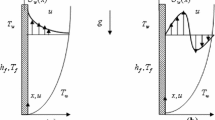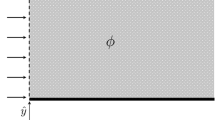Abstract
The development of the transitional boundary layers on a flat plate in uniform and non-uniform incoming flows was experimentally investigated. The mean velocity profiles and the wall shear stresses on a flat plate were measured in the wakes which were generated by circular cylinders and a flat plate ahead of the test plate. A computational Preston tube method (CPM) originally proposed by Nitsche et al. (1983) was adopted and refined to measure the skin friction coefficients in the transitional boundary layer. The CPM was verified as a useful tool to measure the skin-friction over the transitional boundary layer with reasonable accuracy. As the turbulence level in the wakes increased, the starting and ending points of the transition moved progressively upstream. For the same turbulence intensities, the transition was delayed with increase of the length scale. The skin-friction coefficients at the downstream stations in the wake flow were considerably and consistently smaller than the values in the equilibrium turbulent boundary layer of the uniform flow. The transition length for the cases of the plate-wake were shorter than those for the cases of the cylinder-wake as well as the uniform flow.
Similar content being viewed by others
References
Abu-Ghannam BJ; Shaw R (1980) Natural transition of boundary layers — The effects of turbulence, pressure gradient and flow history. J Mech Eng Sci 22: 213–228
Blair MF; Dring RP; Joslyn HD (1989a) The effect of turbulence and stator/rotor interactions on turbine heat transfer. Part I: Design operating conditions. ASME J Turbomach 111: 87–96
Blair MF; Dring RP; Joslyn HD (1989b) The effect of turbulence and stator/rotor interactions on turbine heat transfer Part II: Effect of Reynolds number and incidence. ASME J Turbomach 111: 97–103
Cebeci T; Smith AMC (1974) Analysis of turbulent boundary layers. Academic Press, New York
Champagne FH (1976) The fine-scale structure of the turbulent velocity field. J Fluid Mech 86: 67–108
Clauser FH (1954) Turbulent boundary layers in adverse pressure gradients. J Aeronaut Sci 2: 91–108
Dhawan S; Narasimha R (1958) Some properties of boundary layer flow during transition from laminar to turbulent motion. J Fluid Mech 3: 418–436
Emmons HW (1951) The laminar-turbulent transition in a boundary layer-Part I. J Aeronaut Sci 18: 490–498
Escudier MP; Acharya M (1987) Critique of the computational Preston tube method. Exp Fluids 5: 59–62
Hama FR (1954) Boundary layer characteristics for smooth and rough surfaces. Soc Nav Arch Mar Eng 62: 333–358
Jeon WP (1994) Measurement of transitional boundary layer on a flat plate in a non-uniform incoming velocity profiles of wake. Ph.D. Thesis, Seoul N. University
Jeon WP; Kang SH (1995) Measurement of wall shear stress in transitional boundary layer on a flat plate using computational Preston tube method. Trans KSME 19: 240–250
Kang SH; Yun MS; Jeon WP (1994) Measurement of wall shear stress using Preston tubes. Trans KSME 18: 1873–1880
Kreplin HP; Höhler G (1992) Application of the surface hot film technique to laminar flow investigations. Proc. of the First European Forum on Laminar Flow Technology, DGLR-Rep. 92–06, 123–131
Mayle RE (1991) The role of laminar-turbulent transition in gas turbine engines. ASME J Turbomach 113: 509–537
Mayle RE; Dullenkopf K (1990) A theory for wake-induced transition. ASME J Turbomach 112: 188–195
Narasimha R; Dey J (1989) Transition-zone models for 2-dimensional boundary layers. A review. Sadhana 14: 518–523
Nitsche W (1987) Rebuttal to the “Critique of the computational Preston tube method”. Exp Fluids 5: 63–65
Nitsche W (1994) Strömungsmeßtechnik. Springer Verlag, Berlin, Heidelberg, New York
Nitsche W; Thuenker R; Haberland C (1983) A computational Preston tube method. Turbulent Shear Flows 4: 261–276. Berlin, Heidelberg, New York, Tokyo: Springer
Nitsche W; Haberland C; Thuenker R (1984) Comparative investigations on friction drag measuring techniques in experimental aerodynamics. Proc. 14th ICAS Congress, 391–403
Savill AM (1993) Further progress in the turbulence modelling of by-pass transition. Proceeding of Second International Symposium on Engineering Turbulence Modelling and Measurements, Florence, Italy, 583–592
Schlichting H (1979) Boundary layer theory, 639. McGraw-Hill, New York
Schmidt RC; Patankar SV (1991) Simulating boundary layer transition with low-Reynolds-number k-ɛ turbulence models. ASME J Turbomach 113: 10–26
Sohn KH; Reshotko E (1991) Experimental study of boundary layer transition with elevated freestream turbulence on a heated flat plate. NASA CR 187068
Sundaram S; Yajnik KS (1992) Experimental study on the evolution of a wall layer from a wake. AIAA 12: 2845–2851
Szablewski W (1969) Turbulente Drenzschichten in Ablosenahe. Z Angrew Math 49: 215
Walker GJ (1993) The role of laminar-turbulent transition in gas turbine engines: A discussion. ASME J Turbomach 115: 207–217
Walker GI; Gostelow JP (1990) Effects of adverse pressure gradients on the nature and length of boundary layer transition. ASME J Turbomach 112, 196–205
Weiser N; Mirow P; Nitsche W (1989) Statische und dynamische Meßverfahre zur Transitionsbestimmung an Laminarprofilen. DGLR-Jahrbuch 1: 427–434
White FM (1974) Viscous Fluid Flow. McGraw-Hill, U.S.A.
Author information
Authors and Affiliations
Additional information
The authors are indebted to Korea Science and Engineering Foundation through Turbo and Power Machinery Research Center for financial support.
Rights and permissions
About this article
Cite this article
Jeon, W.P., Kang, S.H. Measurement of transitional boundary layer on a flat plate using a computational Preston tube method. Experiments in Fluids 20, 29–37 (1995). https://doi.org/10.1007/BF00190595
Received:
Accepted:
Issue Date:
DOI: https://doi.org/10.1007/BF00190595




